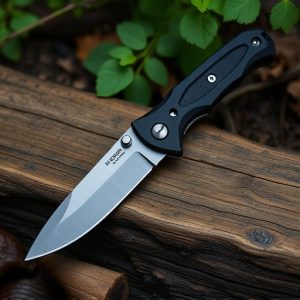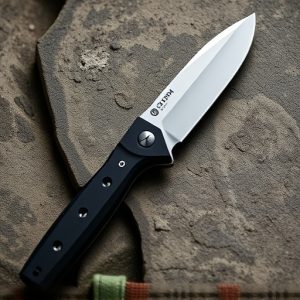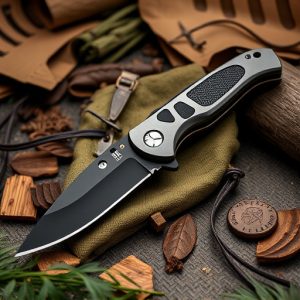Exploring the OTF Automatic Knife: Mechanics, History, Legality, and Craftsmanship
Out-The-Front (OTF) automatic knives represent a niche yet advanced category within the knife indus…….
Out-The-Front (OTF) automatic knives represent a niche yet advanced category within the knife industry, known for their innovative deployment mechanism where the blade extends from the front of the handle. These tools are actuated by a button or switch, offering swift and dependable access to a sharp edge. The intricate engineering behind OTF knives includes precise components like springs, pivot pins, detent mechanisms, and locking systems, all designed for smooth functionality and user safety. Constructed with high-quality materials such as stainless steel or titanium, these knives glide along precise tracks or bearings for optimal performance. With applications ranging from everyday tasks to specialized professional use, OTF automatic knives are both practical tools and showcases of engineering prowess.
The history of OTF automatic knives reveals a transformation from early, bulky, and unreliable models to today's sophisticated and efficient designs. The 20th century saw significant advancements in materials and spring technology, enhancing their performance and making them more user-friendly, which led to their adoption by military, law enforcement, and civilians. Today, manufacturers continue to innovate with OTF automatic knives, focusing on ergonomics and assist mechanisms to ensure they remain relevant across various applications.
Legal considerations for owning an OTF automatic knife are critical as they are subject to specific laws that vary by jurisdiction. Potential owners must be knowledgeable about these regulations, which may classify OTF knives as prohibited or restricted items. The intent behind carrying an OTF knife and the nuances of local laws can significantly impact whether it is legal to carry concealed or openly in a given area. Responsible ownership requires understanding the distinctions between different types of knives and staying informed on legislative changes affecting OTF knife ownership.
Craftsmanship is a hallmark of top-tier OTF automatic knives, with manufacturers selecting premium materials to ensure both structural integrity and visual appeal. The precision machining of each component, particularly the pivot and blade, is crucial for a smooth and reliable action. The complex design of the OTF mechanism demands a deep understanding of physics and engineering to ensure durability and reliability over time. These knives are not only functional tools but also collectible items, appreciated for their practical utility and artistic finesse.
In society, OTF automatic knives serve as both useful tools and coveted collector's items. Their presence is significant in practical settings such as survival situations, tactical operations, and outdoor activities where immediate access to a cutting tool is crucial. The advancements in these knives have led to improvements in ergonomics, safety, and performance, aligning with the evolving needs of users who value both functionality and aesthetic design.
OTF automatic knives represent a blend of innovation, precision engineering, and tradition. This article delves into the intricate mechanics and functionality that define these modern marvels, tracing their evolution from historical artifacts to contemporary tools. We will navigate the legal landscape surrounding OTF automatic knife ownership and carrying, ensuring readers are well-informed. The meticulous craftsmanship behind high-quality OTF knives is a testament to human skill, while their practical applications continue to be relevant in various aspects of modern society. Join us as we explore every facet of the OTF automatic knife phenomenon.
Understanding OTF Automatic Knives: The Mechanics and Functionality
OTF, or Out-The-Front, automatic knives represent a unique class within the broader category of knives, offering a blend of utility and technological sophistication. These knives feature a blade that deploys from the front of the handle, propelled by a compressed spring mechanism or a combination of gravity and inertia. The deployment process is typically actuated by a button or switch located on the side or top of the handle. This design ensures swift and reliable blade extension, enabling users to quickly transition from a closed to an open state with a simple manipulation of the activation device.
The mechanics behind an OTF automatic knife are a marvel of precision engineering. The internal components, including the spring, pivot pin, detent mechanism, and locking system, must all be finely calibrated to allow for smooth operation and safe handling. The blade, often made from durable materials like stainless steel, glides along tracks or ball bearings, facilitating a sleek and seamless motion. Users can appreciate the functionality of OTF knives in various applications, from everyday tasks to professional use, where rapid deployment of the knife is advantageous. Understanding the intricacies of these mechanisms not only enhances user safety but also highlights the innovation and care that goes into the design and manufacture of such precision instruments.
The Evolution of OTF Automatic Knives: A Historical Perspective
The concept of an automatic knife, more commonly known as an Out-The-Front (OTF) knife, has a fascinating history that intertwines with technological advancements and shifting legal landscapes. The earliest iterations of OTF knives can be traced back to the 19th century, where the mechanism for such a blade was patented. These initial designs were cumbersome and not entirely reliable, but they laid the groundwork for the modern OTF automatic knife. As the years progressed, the intricate internal workings necessary for the knife’s operation became more refined, leading to smoother deployments and enhancements in safety features.
The 20th century saw significant advancements in materials and engineering, which greatly improved the functionality and durability of OTF knives. The introduction of stainless steel and titanium allowed for stronger, lighter blades, while innovations in spring technology made the action faster and more responsive. During this period, OTF automatic knives transitioned from novelty items to serious tools for military and law enforcement personnel, as well as for civilians who appreciated their utility and sleek design. Today, OTF knives continue to evolve, with manufacturers focusing on integrating assist mechanisms and improving the ergonomics of both the handle and deployment system. This ongoing evolution reflects a commitment to innovation within the field, ensuring that the OTF automatic knife remains a cutting-edge tool for those who rely on its unique features. Keywords: OTF automatic knife, historical perspective, evolution, technological advancements.
Legal Considerations for Owning and Carrying an OTF Automatic Knife
When considering the ownership and carriage of an OTF, or Out-The-Front, automatic knife, it’s crucial to be aware of the legal framework governing such devices due to their design and functionality. Laws vary by jurisdiction, with some regions having stringent regulations that categorize these knives as either prohibited or restricted items. Owners must familiarize themselves with local statutes, which often differentiate between manual folding knives and automatic knives like the OTF variety. The legality of carrying an OTF knife typically hinges on the intent and the specific laws in place. For instance, some locations may allow for concealed carry of these knives but prohibit open carry, while others may have no restrictions on ownership but impose strict conditions on how and where they can be carried.
Prospective owners should verify that their intended use of an OTF automatic knife aligns with the prevailing legal standards in their area. This includes understanding the distinction between different types of knives, as well as the implications of federal, state, and local laws. It’s also imperative to stay informed about any changes to legislation that could affect the legality of owning or carrying an OTF knife. Compliance with these legal considerations is not just a matter of avoiding penalties; it ensures responsible ownership and use of these sophisticated tools. Those who plan to purchase or carry an OTF automatic knife should prioritize due diligence, consult local law enforcement agencies for clarification when necessary, and always adhere to the regulations set forth by the governing bodies within their locale.
The Craftsmanship Behind High-Quality OTF Automatic Knives
Crafting a high-quality one-time flip (OTF) automatic knife is a testament to the skill and dedication of knife makers. The process begins with selecting premium materials; typically, high-grade stainless steel or titanium is used for both durability and aesthetics. The metal undergoes rigorous machining processes, where precision engineering shapes it into the components that will eventually assemble into the finished knife. Each element, from the pivot to the blade itself, is meticulously crafted to ensure a smooth and reliable operation.
The mechanism at the heart of an OTF automatic knife is a marvel of mechanical design. It requires intricate knowledge of physics and engineering principles to function flawlessly. The bearing system must be designed to withstand tens of thousands of deployments without failure, ensuring the blade unfolds swiftly and securely when needed. The balance between the weight distribution and the tension on the internal springs is critical for a fluid action that can only be achieved through extensive testing and refinement. The craftsmanship behind such knives not only results in a tool of exceptional functionality but also an art piece admired by collectors and professionals alike.
Practical Applications and the Role of OTF Automatic Knives in Modern Society
OTF, or One-Time-Flip, automatic knives have carved out a niche in the realm of practical tools for various applications. Their design, which allows for a single motion to deploy the blade, makes them exceptionally swift and reliable in use. This feature is particularly advantageous in situations where rapid deployment of the knife is necessary, such as in survival scenarios, tactical operations, or everyday tasks that require a quick response tool. The OTF automatic knife’s spring-assisted mechanism ensures smooth and efficient blade deployment, which can be a significant safety and time-saving benefit for users engaging in activities like hunting, fishing, or outdoor expeditions where having a reliable cutting instrument on hand is crucial.
In modern society, the role of OTF automatic knives has become more nuanced. Beyond their utility as tools for survival and outdoor recreation, they serve as collectibles for enthusiasts and as subjects for regulation within various legal frameworks due to their potential for misuse. The knife community often highlights the precision engineering and craftsmanship that go into these devices, making them not only functional but also objects of admiration. With advancements in materials science and design, OTF automatic knives are now more durable, safer, and more ergonomically designed than ever before. They continue to evolve, offering users a blend of practicality and sophistication that aligns with contemporary needs and preferences.


